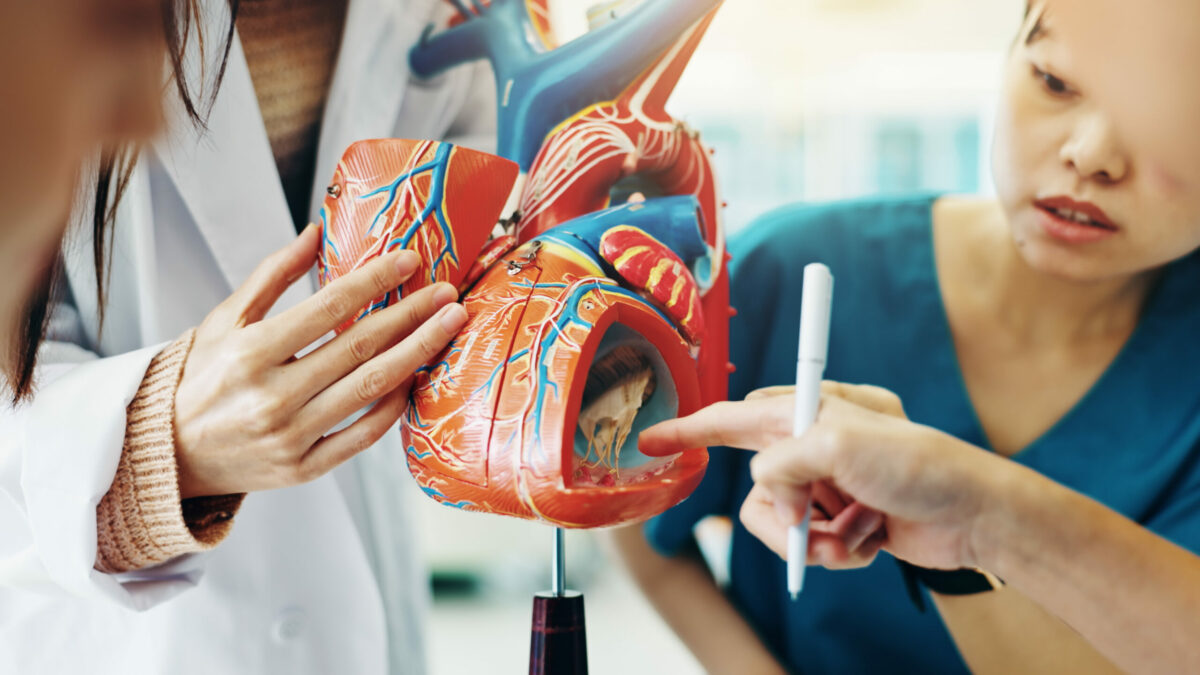A congenital heart defect (present at birth) in which the tricuspid valve does not develop properly is called an Ebstein anomaly. This valve separates the top and bottom right chambers of the heart. In people with this condition, it does not close properly, which causes blood to flow backward making it hard for the heart to pump blood. Sometimes, the heart may grow larger than usual in people with Ebstein anomaly.
Usually, physicians prescribe different treatments for people with this congenital heart defect because it depends on the symptoms, severity of the condition, other existing health problems, and other factors. Without treatment, this condition may lead to heart failure. In most cases, treatment includes medications, surgery, and other procedures when needed.
Symptoms
While some people do not have symptoms at all, others may experience severe ones and other health problems as well. In some cases, the Ebstein anomaly symptoms happen later in life. Check below some symptoms of this congenital heart defect:
- Extreme tiredness (fatigue)
- Pounding, fast, or irregular heartbeats
- Shortness of breath
- Gray or blue lips or fingernails (sometimes, it is difficult to notice this symptom because it depends on the skin color)
You should see a doctor if you notice in your child the following symptoms. For example trouble breathing, irregular heartbeats, blue or gray fingernails, or tiredness.
Causes
Healthcare providers do not know the exact cause of this congenital heart defect. However, to understand more about this condition it is important to know more about how the heart works.
In normal circumstances, the heart has four chambers the atria (2 upper chambers that receive blood) and ventricles (2 lower chambers that pump blood). To maintain the blood flow in one direction are responsible valves located between the heart chambers. These valves also have either two or three strong and thin flaps (also called leaflets or cusps). When a valve closes, it interrupts blood flow to the next chamber and prevents blood from flowing backward in the previous one.
Furthermore, in a healthy person, the tricuspid valve is located between the two right chambers of the heart. However, in people with Ebstein anomaly, this valve is located lower than usual and has changed leaflets. As a result, it leads the blood to flow backward, which puts extra strain on the heart. In such cases, this condition is called tricuspid valve regurgitation.
What Diseases Are Associated with Ebstein Anomaly?
Those who are born with this congenital heart defect also may have other heart problems. For example:
- Patent foramen ovale (PFO) or atrial septal defect – This is another congenital heart defect in which a hole in the heart that normally should close after birth, remains open. This hole usually appears between the two upper heart chambers.
- Arrhythmias – People with this condition may feel a pounding, racing, or fluttering heartbeat.
- Wolff-Parkinson-White (WPW) syndrome – In people with this condition, there is an additional signaling pathway between the upper and lower chambers of the heart, which leads to fainting and fast heart rate.
Risk Factors
This condition often happens during pregnancy in the womb. The baby’s heart begins to form and work in the first 6 weeks of pregnancy. Moreover, during this time, the major blood vessels that come to and go from the heart start to develop. Commonly, in this period congenital heart defects occur.
Experts do not know the exact cause of what elevates the risk of Ebstein anomaly but they think genetics and certain environmental factors could play a role. Furthermore, taking medicines that contain Lithium during pregnancy also is associated with an increased risk of Ebstein anomaly in an unborn baby.
Complications
People with this condition also may experience some complications, especially without treatment. Examples include:
- Stroke
- Arrhythmia (irregular heart rhythm)
- Sudden cardiac arrest
- Heart failure
Can Women with Ebstein Anomaly Have a Successful Pregnancy?
Commonly, people with mild Ebstein anomaly have a successful pregnancy. However, pregnancy, labor, and delivery tend to put extra strain on the heart, which may lead to serious complications that cause concerns for the baby or mother.
In any case, before pregnancy, you should consult with your healthcare professional about the potential risks and complications.
Diagnosis
Physicians usually perform a physical examination and listen to the heart and lungs using a stethoscope to diagnose the condition. However, they also may perform some tests to confirm the condition and exclude others that cause similar symptoms. For example:
- Pulse oximetry – During this test, doctors will measure levels of oxygen in the blood.
- Echocardiogram – This test uses sound waves to make images of the beating heart. It can show how the blood flows through the heart and its valves.
- Electrocardiogram (ECG or EKG) – This is a painless test in which physicians measure the electrical activity of the heart.
- Holter monitor – This is a specific portable EKG device that records the heart’s activity during the day.
- Imaging tests – Physicians usually perform chest X-rays and cardiac MRI (magnetic resonance imaging) to get detailed images of the heart, blood vessels, tricuspid valve, and others.
- Exercise stress tests – During these tests, physicians check your heart while you are walking on a treadmill or riding a stationary bike.
- EP (electrophysiology study) – This is a specific procedure that involves a thin and flexible tube (catheter) that is inserted into the heart through a blood vessel. It is used to record the electrical activity of the heart. Moreover, treatment for irregular heart rhythm may be done through EP in some cases.
- Cardiac catheterization – This is a specific test that measures the pressure and oxygen levels in different heart parts.
Treatment
Commonly, treatment among people with Ebstein anomaly is different because it depends on the severity of the condition, symptoms, age, and other factors. The goal of the treatment is to lessen the symptoms and reduce the risk of complications (such as heart failure and arrhythmia).
In addition, for people with mild Ebstein anomaly that does not cause symptoms, physicians usually recommend regular checkups including a physical examination, imaging tests, and other procedures at least once per year.
Medications
Doctors may recommend the following medicines to prevent certain complications and reduce the symptoms. For example:
- Medicines to control irregular heartbeats
- Some medications to prevent fluid buildup in the body
- Anticoagulants (also called blood thinners) also are recommended by doctors because people with Ebstein anomaly and a hole in the heart may develop blood clots
Surgery
Commonly, surgery is recommended for people with a severe form of this congenital heart defect or who experience severe symptoms (such as stroke or arrhythmia). Check below some surgeries used to treat Ebstein anomaly:
Tricuspid valve repair
This is an open-heart procedure in which surgeons with repair the holes or tears in the valve leaflets or remove extra tissue that forms near the valve opening. In some cases, the damaged valve should be repaired again or replaced later in life.
Tricuspid valve replacement
This surgery is performed when repairing the valve is not possible. Replacement of the damaged valve can be done through open-heart surgery or minimally invasive surgery. In most cases, the replaced valve is made from cow, pig, or human heart tissue (biological valve). Usually, mechanical valves are not used for replacement of the tricuspid valve.
Other Treatments
- Atrial septal defect closure – This is a surgery that closes the hole in the heart. However, other heart problems also may be repaired.
- Maze procedure – This treatment option is often recommended for people with Ebstein anomaly and arrhythmia. It usually is done during the valve repair or replacement. It involves small incisions made in the upper chambers of the heart to produce a maze or pattern of scar tissue that blocks the electricity and irregular heartbeats. In addition, cold or heart energy also can be used to make scars.
- Radiofrequency catheter ablation – This is an effective treatment option for people with arrhythmia. It involves small catheters (tubes) into a blood vessel that are guided by your doctor to the heart. Thereafter, they will deliver radiofrequency energy through these catheters to damage a small heart region and form scar tissue. As a result, scars block the heart signals that cause irregular heart rhythms.
- Heart transplant – In some cases, physicians recommend a heart transplant for people with severe Ebstein anomaly because other treatments do not work.
Frequently Asked Questions
What valve of the heart is affected in people with Ebstein anomaly?
This is a rare congenital heart defect (present at birth) in which the valve located between the two right chambers (top and bottom) does not close properly. It is called a tricuspid valve.
What defects are associated with Ebstein anomaly?
Commonly, people with this condition also have other heart problems including a hole in the wall that divides the upper chambers of the heart (atrial septal defect or patent foramen ovale). However, defects in other heart parts also may occur. Consult with your healthcare professional for more details.
What causes Ebstein’s anomaly?
While experts do not know the exact cause of this congenital heart defect, they think certain genes, environmental factors, and medications could play a role. Furthermore, the risk of Ebstein anomaly increases in children whose mothers take Lithium or Benzodiazepines during pregnancy. Ask your healthcare provider if you have additional questions.8




